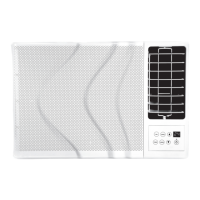PGD4, PGS4, Series G, H WPG4 Series D, H Ultra Low NOx: Installation Instructions
Manufacturer reserves the right to change, at any time, specifications and designs without notice and without obligations.
24
Dehumidification Cooling Fan Speed Set-up:
IMPORTANT: Dehumidification control must open control circuit on
humidity rise above set point.
Use of the dehumidification cooling fan speed requires use of either a 24
VAC dehumidistat or a thermostat which includes control of a 24 VAC
dehumidistat connection. In either case, the dehumidification control
must open the control circuit on humidity rise above the
dehumidification set point.
1. Move shunt jumper on IGC board to “DH” (See Fig. 21).
2. Refer to airflow table (Table 9) to determine allowable speeds for
the dehumidification cooling fan speed. Speeds that are not allowed
are shaded in Table 9.
3. Connect selected speed tap wire to “DHUM” terminal on the IGC
board. Verify that static pressure is in the acceptable range for the
speed tap to be used for dehumidification cooling.
Continuous Fan Speed Set-up:
To change continuous fan speed:
1. Remove existing speed tap wire from the “FAN” terminal on the
IGC.
2. Connect the desired speed tap wire on the “FAN” terminal on the
IGC board.
Cooling Sequence of Operation
With the room thermostat SYSTEM switch in the COOL position and
the FAN switch in the AUTO position, the cooling sequence of
operation is as follows:
1. When the room temperature rises to a point that is slightly above
the cooling control setting of the thermostat, the thermostat
completes the circuit between thermostat terminal R to terminals Y
and G.
2. The normally open contacts of energized contactor (C) close and
complete the circuit through compressor motor (COMP) to
condenser (outdoor) fan motor (OFM). Both motors start instantly.
3. The set of normally open contacts on the interface fan board (IFB)
are closed which energizes a circuit to the indoor fan motor (IFM).
NOTE: Once the compressor has started and then stopped, it should not
be started again until 5 minutes have elapsed. The cooling cycle remains
on until the room temperature drops to a point that is slightly below the
cooling control setting of the room thermostat. At this point, the
thermostat breaks the circuit between thermostat terminal R to terminals
Y and G. These open circuits deenergize contactor coil C. The condenser
and compressor motors stop. After a 60-sec. delay, the blower motor
stops. The unit is in a standby condition, waiting for the next call for
cooling from the room thermostat.
A200280
Fig. 21 – Ultra Low NOx Single Phase IGC Board
Table 7 – Color Coding for Indoor Fan Motor Leads
Black = High Speed
Orange = Med-High Speed
Red = Med Speed
Pink = Med-Low Speed
Blue = Low Speed
DH
DH
DH
DH
Shunt in no
dehumidification
position
Shunt in
dehumidification
position
2-Pin Terminal

